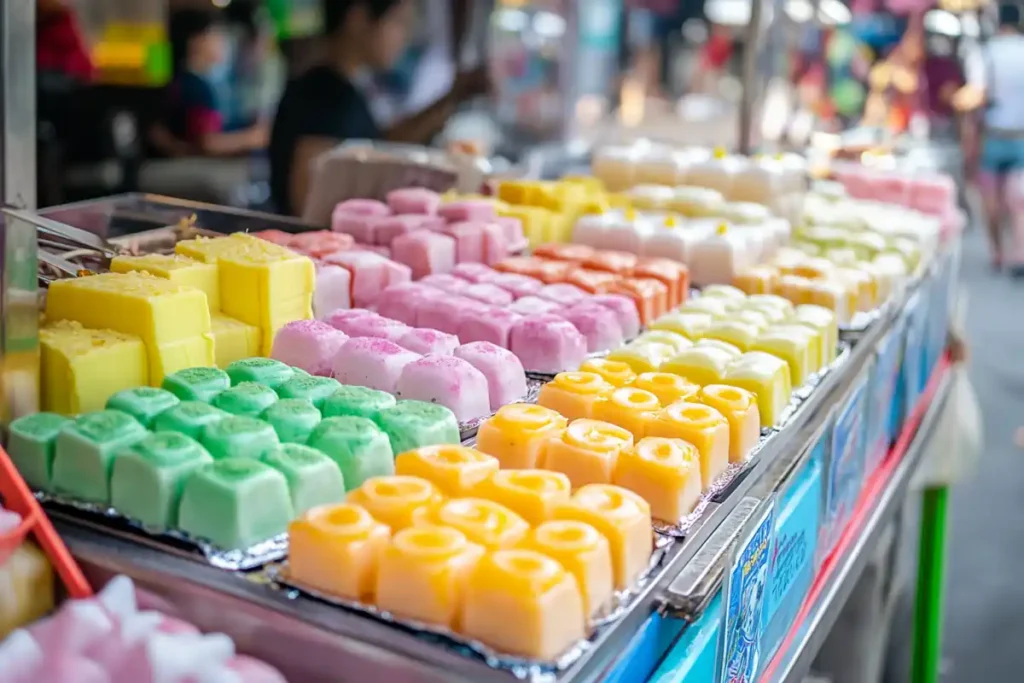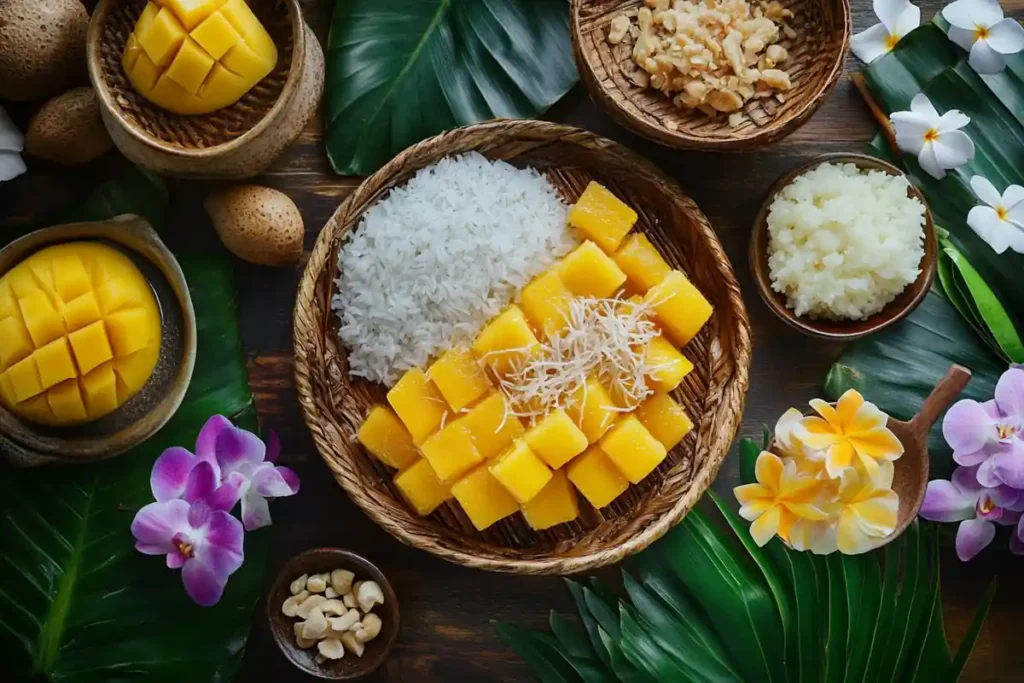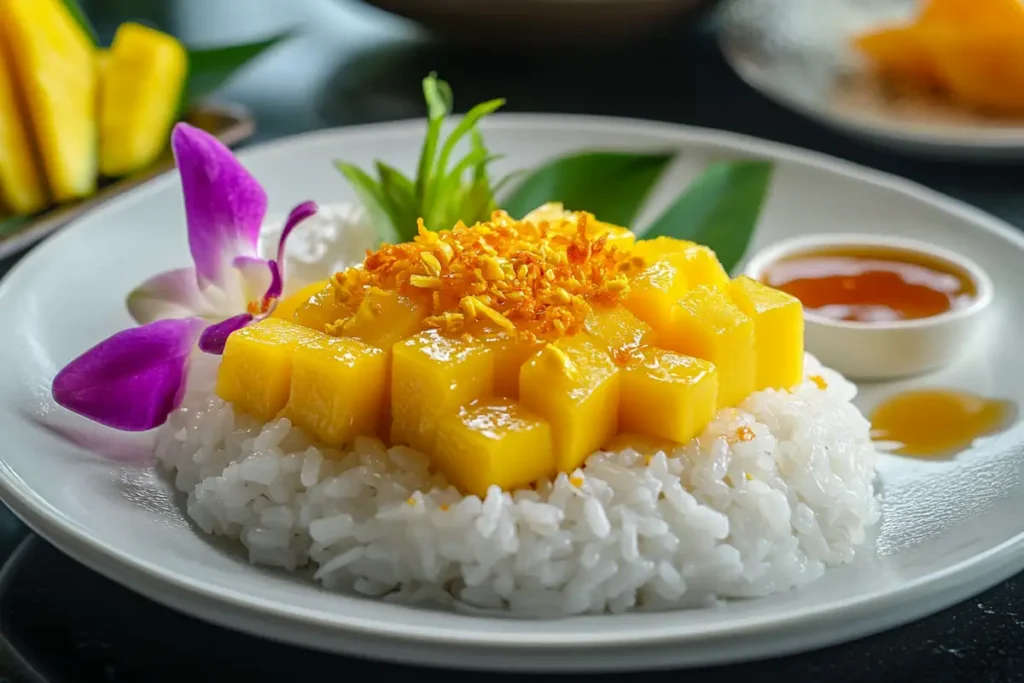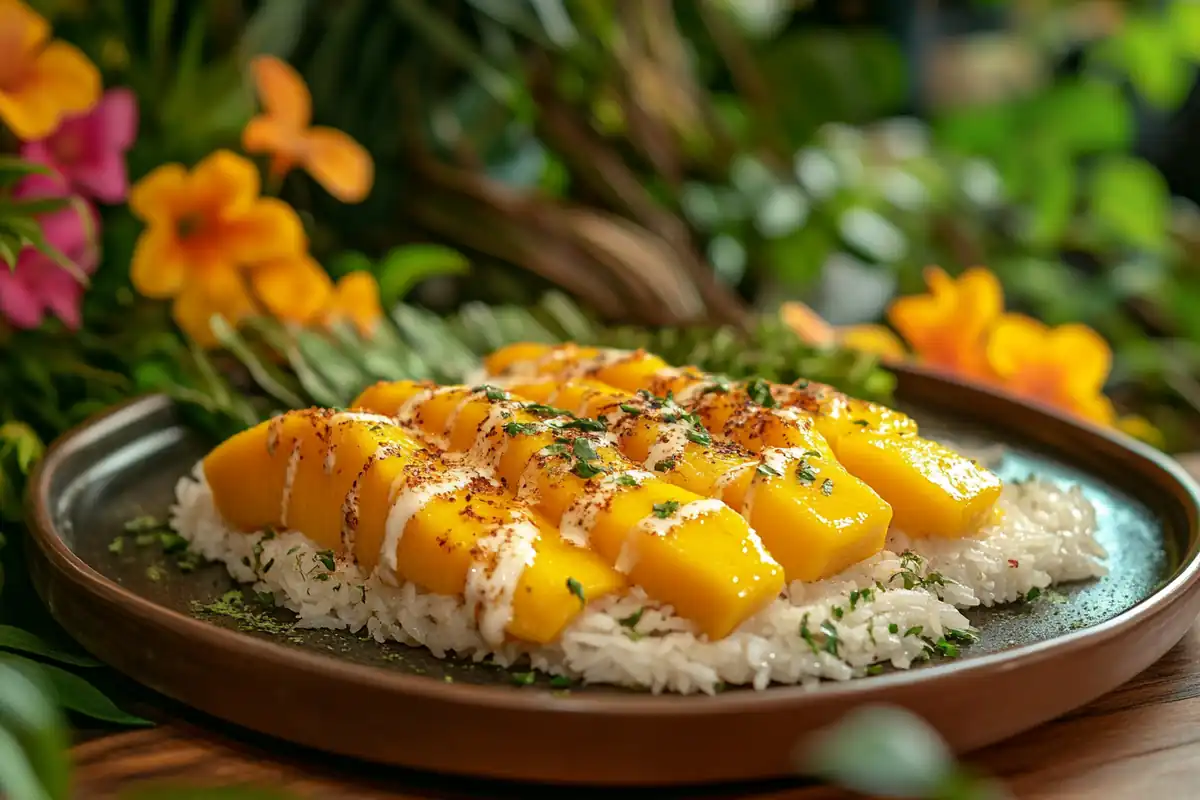Discover the vibrant world of Thai desserts, where unique flavors, cultural richness, and creative presentations come together. From the globally adored mango sticky rice to hidden gems like Khanom Buang and Tub Tim Krob, Thai desserts are as delightful as they are diverse. This article dives into Thailand’s most iconic desserts, exploring their history, ingredients, and why they’ve captured hearts worldwide.
Introduction and Context
What is the Most Popular Dessert in Thailand?
Thai cuisine is synonymous with rich flavors, but its desserts are equally remarkable. Among the many delectable sweets, mango sticky rice reigns supreme as the most popular dessert in Thailand. Known locally as “Khao Niew Mamuang,” this dish is a quintessential part of Thai culture and a must-try for anyone visiting the Land of Smiles.
But what makes mango sticky rice so beloved? The answer lies in its perfect balance of sweetness, creamy textures, and fresh ingredients. The combination of fragrant glutinous rice, juicy mango slices, and indulgent coconut milk creates an unforgettable taste that transcends borders.
Why Are Thai Desserts Unique?
Thai desserts are an art form, deeply rooted in tradition and infused with cultural influences. What sets them apart is the use of natural ingredients like coconut, palm sugar, and pandan, which create distinctive flavors and textures.
Cultural Influences
Thailand’s dessert recipes showcase the country’s rich history, as Buddhist traditions and royal cuisine heavily influence them. Palace chefs originally crafted many sweets, blending local flavors with techniques that Portuguese settlers introduced during the Ayutthaya era.
Signature Ingredients in Thai Desserts
Simple techniques and a reliance on fresh, natural ingredients define Thai desserts. Cooks use coconut milk to add creaminess, pandan leaves to bring a subtle floral note, and palm sugar to contribute a caramel-like sweetness. They often incorporate sticky rice, mung beans, and taro root into traditional recipes, showcasing the versatility of Thai cuisine.
Thai sweets are not just about taste; they are an experience that connects you to the country’s history, traditions, and people. Up next, we’ll explore the star of Thai desserts: mango sticky rice!
Exploring the Most Popular Dessert in Thailand
The Most Popular Dessert in Thailand – Mango Sticky Rice

When you think of Thai desserts, mango sticky rice likely comes to mind first—and for good reason! This simple yet exquisite dessert has become an international ambassador of Thai cuisine. Its ability to captivate both locals and tourists lies in its harmonious blend of flavors and textures.
What is Mango Sticky Rice?
People have cherished mango sticky rice, or “Khao Niew Mamuang,” as a traditional Thai dessert that has stood the test of time. Cooks prepare it with glutinous rice, fresh mango slices, and a generous drizzle of coconut milk. Though it appears humble, this dessert holds a significant place in Thai food culture and often features in celebrations and festivals.
The dessert’s origins date back centuries, with historical records suggesting its popularity surged during the late Ayutthaya period. Mango sticky rice not only reflects Thailand’s agricultural abundance but also its commitment to crafting dishes that nourish the soul.
Key Ingredients
Each ingredient in mango sticky rice plays a crucial role in delivering its signature taste:
- Glutinous Rice: The base of the dish, this type of rice becomes soft and chewy when cooked.
- Coconut Milk: Adds richness with its creamy, slightly sweet flavor.
- Fresh Mango: Ripe mangoes bring natural sweetness and a juicy, refreshing contrast.
- Palm Sugar: Enhances the coconut milk’s sweetness without overpowering the dish.
- Sesame Seeds or Mung Beans: Often sprinkled on top for a nutty crunch.
How is Mango Sticky Rice Made?
The process of making mango sticky rice is surprisingly straightforward, yet each step requires attention to detail to achieve perfection:
- Prepare the Sticky Rice: Rinse and soak glutinous rice to remove excess starch, then steam it until tender.
- Make the Coconut Sauce: Simmer coconut milk with palm sugar and a pinch of salt for balance.
- Combine the Rice and Sauce: Pour the coconut milk mixture over the cooked sticky rice and let it absorb the flavors.
- Slice the Mangoes: Peel and cut ripe mangoes into thin, even slices.
- Assemble the Dessert: Plate the sticky rice beside the mango slices, drizzle with extra coconut sauce, and garnish with sesame seeds or mung beans.
Why Mango Sticky Rice is Loved Globally
Taste and Texture Appeal
The appeal of mango sticky rice lies in its delightful contrast of flavors and textures. The sticky rice is slightly sweet and chewy, the mango is juicy and tangy, and the coconut milk ties it all together with a creamy finish. Each bite offers a perfectly balanced harmony that’s hard to resist.
Role in Celebrations
In Thailand, mango sticky rice is much more than a dessert—it’s a celebration of seasonal abundance. Mango season, which runs from March to May, marks the peak availability of this treat. It’s often served during Songkran, the Thai New Year, as a symbol of joy and togetherness.
From Bangkok’s bustling street markets to high-end restaurants worldwide, mango sticky rice continues to win over hearts with its simplicity and soul-soothing flavors.
Top 5 Other Popular Thai Desserts
Thailand is a paradise for dessert lovers, offering a diverse array of sweet treats that captivate the senses. While mango sticky rice takes the crown as the most popular dessert, many others are equally enchanting. Below, we explore five iconic Thai desserts that showcase the creativity and richness of Thai culinary traditions.
Other Iconic Thai Desserts Worth Mentioning
Thai Coconut Ice Cream
Vendors serve Thai coconut ice cream as a cool, refreshing street food staple bursting with tropical flavors that has won hearts across the globe. They make it using coconut milk instead of dairy, creating a creamy yet light texture.
Served in a coconut shell and often topped with roasted peanuts, sticky rice, or even sweet corn, it’s a dessert that feels uniquely Thai. This treat reflects the country’s ingenuity in using local ingredients to create something extraordinary.
Khanom Buang (Thai Crispy Pancakes)
Cooks have created Khanom Buang as a traditional Thai dessert that resembles a taco—but sweet! They make these crispy pancakes using rice flour and fill them with either sweet coconut cream or a savory mixture of shrimp and egg.
The sweet version, typically topped with golden threads (egg yolk), is a popular choice among dessert enthusiasts. Watching street vendors craft these intricate treats is an experience in itself, showcasing the skill required to perfect each bite-sized pancake.
Tub Tim Krob (Red Ruby Dessert)
Bright, colorful, and refreshing, Tub Tim Krob is a Thai dessert that perfectly suits the country’s tropical climate. It features water chestnuts coated in tapioca flour, dyed in vibrant red hues, and served in chilled coconut milk.
The crunch of the water chestnuts contrasts beautifully with the creamy coconut milk, making it a favorite for those seeking a light yet satisfying treat. Its striking appearance also makes it an Instagram-worthy option for travelers.
Khanom Chan (Layered Dessert)
A feast for both the eyes and the palate, Khanom Chan is a multi-layered dessert that holds cultural significance in Thailand. The dessert is made from tapioca flour, rice flour, and coconut milk, layered with alternating colors, usually green and white.
Traditionally, Khanom Chan symbolizes prosperity and success, making it a popular choice for auspicious occasions like weddings and religious ceremonies. Each layer is subtly sweet, with a hint of pandan flavor, and the texture is delightfully chewy.
Luk Chup (Miniature Fruit Dessert)
This dessert showcases Thai artistry and creativity. Cooks craft Luk Chup from mung bean paste, meticulously shaping and painting it to resemble miniature fruits and vegetables.
Portuguese marzipan, introduced centuries ago, inspired this dessert. Luk Chup blends delicate craftsmanship with subtle sweetness. Hosts often serve these tiny, colorful creations at events and gatherings to impress guests with their intricate designs.
Thai desserts, much like the country itself, are vibrant, flavorful, and steeped in tradition. From the creamy indulgence of Thai coconut ice cream to the artistic charm of Luk Chup, each dessert offers a unique experience that reflects Thailand’s culinary heritage.
Thai Desserts in Modern Times

Cooks and chefs have rooted Thai desserts in centuries-old traditions, yet they continue to evolve alongside global culinary trends. Today, people celebrate these desserts in their authentic forms and also reimagine them with modern twists, broadening their appeal to a wider audience.
How Thai Desserts Are Evolving
Globalization of Thai Desserts
With the rise of international travel and the popularity of Thai cuisine, traditional Thai desserts have gained a global following. Restaurants and food festivals around the world now feature classics like mango sticky rice, Thai coconut ice cream, and Khanom Chan.
Social media platforms have played a significant role in this global appreciation, with visually striking desserts like Tub Tim Krob and Luk Chup becoming viral sensations. Travelers who fall in love with these treats often seek out Thai restaurants or attempt to recreate the recipes at home, further spreading their appeal.
Fusion Creations
Modern chefs in Thailand and abroad have embraced the challenge of reinventing traditional desserts. These fusion creations often blend the essence of Thai sweets with elements from other cuisines, resulting in innovative dishes that maintain their cultural roots.
For instance, some high-end restaurants serve deconstructed mango sticky rice, where the components are presented as separate yet interconnected elements. Others craft Thai-inspired cakes, ice creams, and pastries, infusing them with pandan, coconut, or tamarind flavors to create unique offerings.
Thai desserts in modern times exemplify how culinary traditions can adapt and thrive without losing their essence. As these desserts continue to inspire chefs and delight food lovers worldwide, their legacy remains strong while embracing innovation.
Experiencing Thai Desserts as a Tourist
Thailand’s culinary scene is a feast for the senses, and its desserts are no exception. For travelers, trying authentic Thai desserts is a delightful way to immerse themselves in the local culture. Whether you’re wandering through bustling street markets or dining in upscale restaurants, Thai desserts promise an unforgettable experience.
Where to Try Thai Desserts in Thailand

Street Food Stalls
Thailand’s vibrant street food culture offers some of the best opportunities to try authentic and affordable desserts. In places like Bangkok’s Chatuchak Market or Chiang Mai’s Night Bazaar, you’ll find vendors selling everything from mango sticky rice to Khanom Buang.
The beauty of street food lies in its accessibility and authenticity. Watching vendors prepare desserts on the spot adds an extra layer of excitement to your culinary journey. Plus, the variety ensures there’s something for everyone—whether you prefer the chewy texture of Khanom Chan or the refreshing chill of Tub Tim Krob.
Upscale Restaurants
For a more refined experience, Thailand’s upscale dining establishments offer gourmet versions of traditional desserts. High-end restaurants like Sra Bua by Kiin Kiin in Bangkok are known for their innovative takes on classics like deconstructed mango sticky rice.
These establishments often present desserts with intricate plating and unique flavor combinations, providing a modern twist on tradition. While the prices are higher, the experience is worth it for those seeking a blend of art and flavor.
For tourists, indulging in Thai desserts is a way to connect with the country’s culture and hospitality. From the bustling streets to elegant dining rooms, each bite tells a story of tradition, innovation, and the love that goes into crafting these sweets.
Frequently Asked Questions
What are traditional Thai desserts made of?
Cooks traditionally rely on natural ingredients such as coconut milk, palm sugar, and pandan leaves to prepare Thai desserts. They often pair these staples with glutinous rice, mung beans, taro, and tropical fruits like mango and jackfruit to create a variety of textures and flavors.
How do you eat mango sticky rice?
You will enjoy mango sticky rice best when you combine all the elements in a single bite. Scoop a little sticky rice, add a slice of mango, and drizzle coconut milk over it. This blend of sweetness, creaminess, and juiciness creates a perfect harmony of flavors.
What is the oldest Thai dessert?
People regard Khanom Chan as one of the oldest Thai desserts, with its history dating back to the Ayutthaya period. Its layered structure symbolizes prosperity, and Thais often serve it during auspicious occasions.
Are Thai desserts healthy?
Cooks typically prepare Thai desserts with natural ingredients, making them healthier than processed sweets. However, some recipes contain more calories because they use coconut milk and palm sugar. Enjoying these treats in moderation helps maintain a balanced diet.
Can I find Thai desserts outside of Thailand?
Yes, Thai desserts are widely available in international Thai restaurants and specialty stores. Dishes like mango sticky rice and Thai coconut ice cream are especially popular in countries with large Thai communities.
What is the most visually appealing Thai dessert?
People admire Luk Chup for its vibrant colors and intricate designs that resemble miniature fruits and vegetables, making it one of the most visually stunning Thai desserts. Its artistic appeal attracts attention during special occasions and often features in Instagram-worthy posts.
